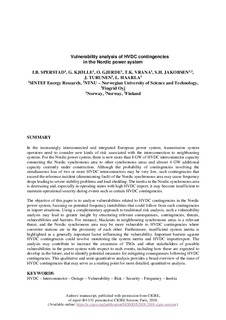| dc.contributor.author | Sperstad, Iver Bakken | |
| dc.contributor.author | Kjølle, Gerd Hovin | |
| dc.contributor.author | Gjerde, Oddbjørn | |
| dc.contributor.author | Vrana, Til Kristian | |
| dc.contributor.author | Jakobsen, Sigurd Hofsmo | |
| dc.contributor.author | Turunen, J. | |
| dc.contributor.author | Haarla, L | |
| dc.date.accessioned | 2019-09-11T13:42:40Z | |
| dc.date.available | 2019-09-11T13:42:40Z | |
| dc.date.created | 2019-03-27T11:07:44Z | |
| dc.date.issued | 2018 | |
| dc.identifier.citation | CIGRE, Session Proceedings 2018, C2-132 | nb_NO |
| dc.identifier.isbn | 978-2-85873-497-9 | |
| dc.identifier.uri | http://hdl.handle.net/11250/2616412 | |
| dc.description.abstract | In the increasingly interconnected and integrated European power system, transmission system operators need to consider new kinds of risk associated with the interconnection to neighbouring systems. For the Nordic power system, there is now more than 8 GW of HVDC interconnector capacity connecting the Nordic synchronous area to other synchronous areas and almost 4 GW additional capacity currently under construction. Although the probability of contingencies involving the simultaneous loss of two or more HVDC interconnectors may be very low, such contingencies that exceed the reference incident (dimensioning fault) of the Nordic synchronous area may cause frequency drops leading to severe stability problems and load shedding. The inertia in the Nordic synchronous area is decreasing and, especially in operating states with high HVDC import, it may become insufficient to maintain operational security during events such as certain HVDC contingencies. The objective of this paper is to analyse vulnerabilities related to HVDC contingencies in the Nordic power system, focusing on potential frequency instabilities that could follow from such contingencies in import situations. Using a complementary approach to traditional risk analysis, such a vulnerability analysis may lead to greater insight by structuring relevant consequences, contingencies, threats, vulnerabilities and barriers. For instance, blackouts in neighbouring synchronous areas is a relevant threat, and the Nordic synchronous area may be more vulnerable to HVDC contingencies where converter stations are in the proximity of each other. Furthermore, insufficient system inertia is highlighted as a generally important factor influencing the vulnerability. Important barriers against HVDC contingencies could involve monitoring the system inertia and HVDC import/export. The analysis may contribute to increase the awareness of TSOs and other stakeholders of possible vulnerabilities in the power system with respect to such events, including how these are expected to develop in the future, and to identify potential measures for mitigating consequences following HVDC contingencies. This qualitative and semi-quantitative analysis provides a broad overview of the issue of HVDC contingencies that may serve as a starting point for more detailed, quantitative analysis. | nb_NO |
| dc.language.iso | eng | nb_NO |
| dc.publisher | CIGRE | nb_NO |
| dc.relation.ispartof | CIGRE, Session Proceedings 2018 | |
| dc.rights | Attribution-NonCommercial-NoDerivatives 4.0 Internasjonal | * |
| dc.rights | Attribution-NonCommercial-NoDerivatives 4.0 Internasjonal | * |
| dc.rights.uri | http://creativecommons.org/licenses/by-nc-nd/4.0/deed.no | * |
| dc.title | Vulnerability analysis of HVDC contingencies in the Nordic power system | nb_NO |
| dc.type | Chapter | nb_NO |
| dc.type | Peer reviewed | nb_NO |
| dc.description.version | acceptedVersion | nb_NO |
| dc.identifier.cristin | 1688151 | |
| dc.relation.project | Norges forskningsråd: 255226 | nb_NO |
| cristin.unitcode | 7548,50,0,0 | |
| cristin.unitname | Energisystemer | |
| cristin.ispublished | true | |
| cristin.fulltext | postprint | |
| cristin.qualitycode | 1 | |

